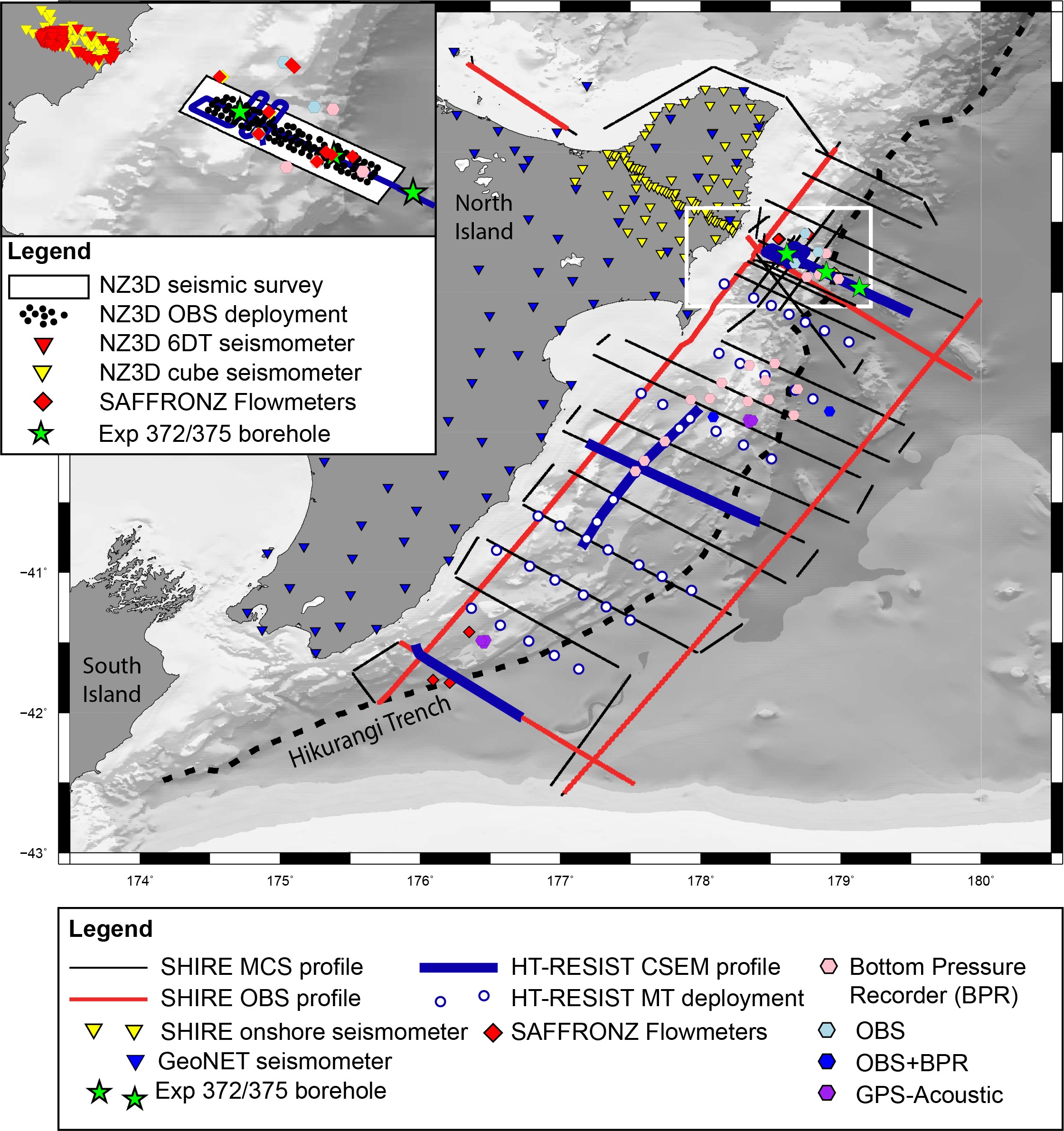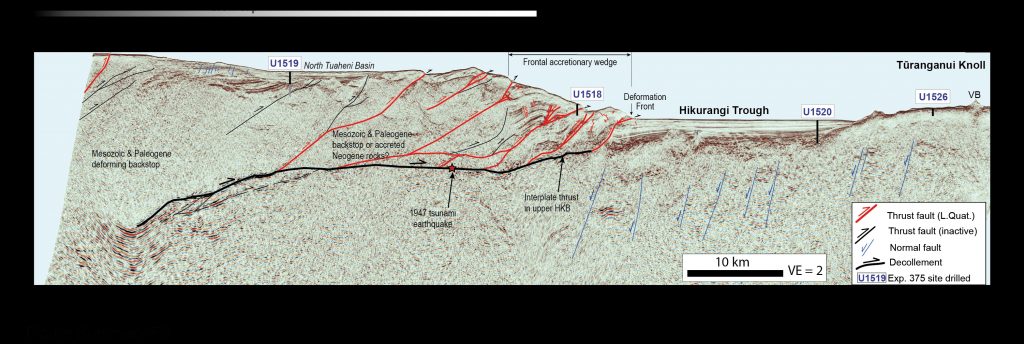Sunday December 9, 2018, 1:15 PM – 5:30 PM
Conveners: Laura Wallace, Dan Bassett, Heather Savage, Samer Naif, Shuoshuo Han , Patrick Fulton
1:15pm | Welcome & Introductory Remarks – GeoPRISMS Chair Demian Saffer
Session 1 – Integrating observations from an unprecedented summer research at Hikurangi
1:20 – 1:35 | Paleoseismic constraints on past earthquake behaviour – Jamie Howarth
1:35 – 1:50 | Summary of IODP Exp 372/375 – Demian Saffer
1:50 – 2:05 | Summary of NZ3D – Nathan Bangs (MCS) and Ryuta Arai and Becky Bell (wide-angle)
2:05 – 2:20 | Summary of SHIRE – Harm van Avendonk (offshore) and Stuart Henrys (onshore)
2:20 – 2:35 | Parallels between Alaska and the Hikurangi margin, and synergies with activities at the Alaska Primary Site – Donna Shillington
2:35 – 3:15 | Discussion of implications for the physical controls on subduction processes
– Structure around SCD key questions, processes or domains (e.g. incoming plate, forearc, megathrust)
3:15 – 3:30 | Coffee break
Session 2 – Future plans
3:30 – 3:45 | Seafloor Observatory installation and plans for ongoing seafloor geodesy and seismology – Laura Wallace
3:45 – 4:00 | SAFFRONZ project and the interplay between hydrogeology and slow slip – Evan Solomon
4:00 – 4:15 | CSEM and MT as a window into hydrogeology – Samer Naif (offshore) and Wiebke Heise (onshore)
4:15 – 4:35 | Space for 2 minute (1 slide) pop-up talks summarizing other synergistic activities
- Earthquake rupture and ground shaking scenario – Yoshi Kaneko
- Seamount subduction prolongs shallow slow slip event in the forearc of the Northern Hikurangi Subduction Zone, New Zealand – Heather Shaddox
- Hikurangi Full Waveform Inversion – Adrien Arnulf
- Investigating the Coupling Between Deformation, Pore Pressure, and Fluid Flow in Subduction Forearcs – Tianhaozhe Sun
- – Abhi Ghosh
- Paleoseismic evidence for late Holocene earthquakes & tsunamis: Wairarapa to Northern Hawkes Bay – Jessica Pilarczyk
- A biomarker thermal maturity study of EXP375 samples – Genevieve Coffey
- Hikurangi Friction: Expedition 375 – Hannah Rabinowitz
- Tracing volatiles from the seafloor through volcanic arcs using stable isotopes and thermodynamic modeling – Gabe Epstein
- Reconciling Slow Slip Events with Distributed Visco-brittle Deformation – Adam Beall
- Transition from rifting to seafloor spreading in the N. TVZ- Havre Trough back-arc – Cindy Ebinger
- Hikurangi – Martha Savage
4:35 – 5:15 | Open Discussion
– What gaps in data/knowledge remain? What additional work needs to be done?
The Hikurangi margin offers an outstanding opportunity to address many of the key topics of GeoPRISMS Subduction Cycles and Deformation. Major international experiments to investigate subduction processes at the Hikurangi margin have taken place in the last year including two IODP drilling expeditions to investigate shallow slow slip events, and two seismic experiments with the R/V Langseth and R/V Tangaroa to investigate controls on plate coupling and slow slip. The objectives of a Hikurangi margin mini-workshop are to discuss new observations from the New Zealand focus site and their implications for an integrated understanding of subduction processes, as well as planning for upcoming experiments.
The first half of the miniworkshop will introduce the latest results from the recent GeoPRISMS-related research efforts at the Hikurangi margin (including IODP drilling and seismic experiments), and a discussion of the implications of these for GeoPRISMS SCD questions. The second half of the miniworkshop will consist of presentations on upcoming plans for field experiments and research at the Hikurangi focus site, and discussion on coordination of these efforts. We will also discuss any research gaps that might exist. In addition to a small number of overview talks on recent and future experiments, we will offer the opportunity for a limited number of short (~2 minutes) pop-up talks on synergistic activities at the Hikurangi subduction zone.
In addition to researchers focused on the Hikurangi margin, we welcome attendees interested in subduction deformation and megathrust processes in Cascadia and Alaska, to cross-fertilize ideas and research outcomes among all three of the GeoPRISMS primary sites. Student and early-career scientist participation is also encouraged.
Investigating subduction processes at the Hikurangi margin, New Zealand
2018 GeoPRISMS mini-workshop at AGU
December 9, 2018, Washington DC
Conveners: Laura Wallace1,2, Dan Bassett1, Samer Naif3, Patrick Fulton4, Heather Savage3, Shuo Shuo Han2
1GNS Science, New Zealand, 2Univ. Texas Institute for Geophysics, 3Lamont-Doherty Earth Observatory, Columbia University, 4Cornell University
A mini-workshop to discuss the latest research results from the Hikurangi subduction zone (New Zealand), was held on Sunday afternoon before Fall AGU began in Washington, D.C. The mini-workshop had a record turnout, with 116 registrants from 9 different countries, the largest number of participants of any previous GeoPRISMS mini-workshop. A particular priority of this workshop was to get the broader community up to speed on the range of research activities and major experiments underway to better understand the Hikurangi subduction zone, and to facilitate discussion to better integrate results between these projects.
Subduction of the Pacific Plate beneath New Zealand’s North Island occurs at the Hikurangi subduction margin. The Hikurangi margin offers an outstanding opportunity to address many of the key topics of GeoPRISMS Subduction Cycles and Deformation, as outlined in the New Zealand primary site implementation plan. In particular, the strong along-strike variations in megathrust behavior and characteristics make it an ideal location to investigate the physical controls on subduction margin deformation and slip behavior, including seismic vs. aseismic slip.
Data acquisition and analysis at the Hikurangi margin are ongoing by scientists from New Zealand, the United States, Japan and Europe. Major experiments to investigate Hikurangi subduction processes have taken place in the last year including two IODP drilling expeditions to investigate slow slip processes (Expeditions 372 & 375), and two seismic experiments with the R/V Langseth and R/V Tangaroa to investigate controls on plate coupling and slow slip (Figure 1). Additional NSF and New Zealand-funded experiments have just taken place in the first few months of 2019.

Figure 1. Map of the North Island and offshore Hikurangi subduction zone with a summary of some instrumentation and recent offshore and onshore experiments undertaken at the Hikurangi subduction margin over the last 3 years.
The meeting began with an overview from Jamie Howarth (Victoria University of Wellington) on paleoseismological studies to establish a record of, and evidence for, large subduction zone earthquakes at the Hikurangi margin. Ongoing efforts in this area involve both onshore proxies for paleo-earthquakes, as well as offshore (turbidite) studies. Demian Saffer (Penn State) overviewed the results of recently completed IODP drilling (Figure 2), and discussed the implications of these results for controls on slow slip event processes. A number of active source seismic imaging investigations took place in 2017/2018 (Figure 1). Nathan Bangs (UTIG), Ryuta Arai (JAMSTEC), and Rebecca Bell (Imperial College, London) presented an overview of the 3D multi-channel seismic survey (NZ3D) to image the shallow slow slip region at north Hikurangi in unprecedented detail. Nathan Bangs also presented preliminary results of the first phase of the SHIRE experiment to image along-strike variations in properties of the subduction zone. Stuart Henrys (GNS Science) overviewed plans for the final, onshore phase of SHIRE that was successfully completed in early March 2019. The first part of the mini-workshop concluded with an overview from Donna Shillington on parallels between the Hikurangi margin megathrust and aspects of the megathrust in Alaska. There are striking parallels between Hikurangi and Alaska, offering clear research opportunities for the future.
The second half of the mini-workshop focused on future plans at the Hikurangi margin. Laura Wallace (GNS Science/UTIG) overviewed ongoing and upcoming seafloor geodetic experiments (Figure 1) to clarify the nature of offshore interseismic deformation and the distribution of slow slip events on the shallow megathrust. Evan Solomon (University of Washington) discussed plans for an experiment to undertake sampling of sediment and fluids from offshore seeps, acquire heat flow data, and deploy seafloor flow-rate meters (Figure 1) to evaluate the role of fluids in Hikurangi megathrust behavior (the SAFFRONZ project). The SAFFRONZ cruise was successfully completed on the R/V Revelle, in February of 2019. Samer Naif (LDEO) overviewed their recently completed HT-RESIST experiment (December 2018/March 2019; Figure 1) to deploy offshore MT instruments and undertake controlled-source electromagnetic (CSEM) surveys to map along strike variations in the fluid content and the relationship of this to megathrust behavior. All of these studies are supported by a combination of NSF/GeoPRISMS funding, and funding from international partners in New Zealand, Japan, and the U.K. Following the talks we had short pop-up talks from a number of participants to overview additional investigations at Hikurangi.

Figure 2: Seismic image (after Barker et al., 2018, GRL) showing the transect that was drilled on IODP Expeditions 372 and 375 to investigate shallow slow slip events at the offshore northern Hikurangi margin.
Large portions of the mini-workshop were devoted to discussion of using these new observations from the New Zealand focus site, to develop an integrated understanding of subduction margin processes from geophysical, geological, and geochemical field perspectives. Many of the themes discussed included (1) the state of the incoming plate and the role of incoming sediment and basement properties in subduction thrust behavior and margin evolution; (2) physical properties of the forearc and megathrust, and the influence of this on megathrust behavior; (3) fluid sources and fluxes, with emphasis on the forearc; (4) the relationship between micro-seismicity, slow slip events, and tremor.
Overall, there are close to 100 scientists from several different countries involved in GeoPRISMS-related studies on the Hikurangi subduction zone. The mini-workshop at Fall AGU offered the first opportunity for many of these scientists to get together to discuss the results of these recent major experiments at the New Zealand focus site, and their implications for deformation and earthquake cycle processes at the Hikurangi margin. It also provided an important opportunity to coordinate efforts for the additional upcoming experiments in 2019, and to explore synergies between the various research groups working there.

